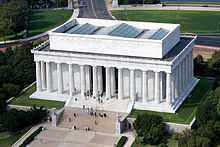Sylacauga marble
Sylacauga marble is found in a belt running through Talladega County, Alabama. It is prized for its pure white color and its crystalline structure. The stone is named after the town of Sylacauga, Alabama, which is sometimes called "the Marble City". Sylacauga marble has been called the "world's whitest".[1] It has been mined for over 160 years, and is used for building, sculpture, and by the paper industry. The Alabama legislature declared marble as the official State Rock in 1969.
Occurrence
Sylacauga marble occurs mainly in Alabama's Talladega County. It runs in a swath 32 miles (51 km) in length, from the Coosa River to just south of the city of Talladega. The deposit is up to 600 feet (180 m) in depth and is focused on the city of Sylacauga, for which it is named.[2]
Major mining operations currently include Omya, Alabama Marble Co., and Imerys. Although the pure white color is most widely known in the market, portions of the deposit produce types with bodies or veining in black pink, gray, and yellow hues.[1][2]
Uses

Sylacauga marble has been praised by sculptors as equivalent to Italy's famous Carrara marble[citation needed], and is noted for its translucency. It was used for the bust of Abraham Lincoln which resides in the United States Capitol rotunda. It was used for the ceilings in the Lincoln Memorial, and was also used in Washington Monument and for the interiors of the United States Supreme Court Building.
Aside from use as sculptural media and as a building stone, the marble is also used in industry as a coating to whiten high-quality paper, for electrical insulation, pigment, and other purposes. It is used in agriculture as a soil amendment.[1]
On 12 September 1969, Alabama's legislature passed Act 755, which made marble the state's official rock.[2]
See also
References
- ↑ 1.0 1.1 1.2 "Alabama marble called whitest in world". The Decatur Daily News (Decatur, Alabama). 6 February 2005. Retrieved 16 October 2010.
- ↑ 2.0 2.1 2.2 "Official State Rock: Marble". Official Symbols and Emblems of Alabama. Alabama Department of Archives and History. 14 January 2010. Retrieved 16 October 2010.
External links
- Geological Survey of Alabama with geological maps showing resource locations within the state